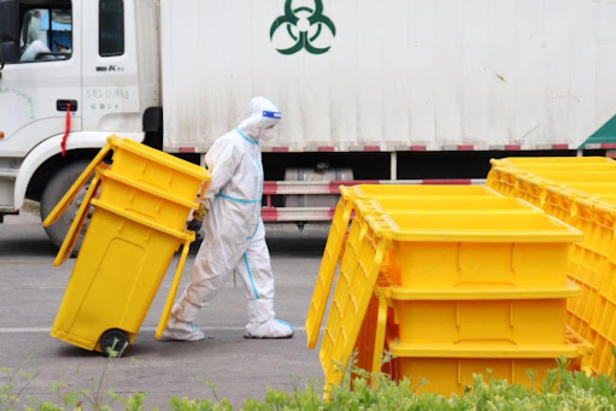Veolia has over 20 years of hazardous waste service experience in China. The all-in-one solution for hazardous waste management could achieve visualized and digitized monitoring throughout the entire process, including collection, transportation, and treatment of medical waste, ensuring that the medical waste produced is controllable, manageable, and traceable and preventing incidents such as loss of medical waste.
Procedures for treating medical waste
Collection from the source: Once medical waste is generated, the waste is sorted out by medical personnel according to the “Classification Catalog of Medical Waste” and placed in designated packaging or containers.
Provisional storage: In areas that are distant from medical zones, food processing zones, personnel activity zones, and residential waste storage sites, provisional storage facilities and equipment for medical waste are established and regularly disinfected and cleaned by medical institutions.
Transfer and relocation: Medical waste is regularly transported using specialized vehicles to disposal plants licensed by the environmental protection department. For each transfer, a “Hazardous Waste Transfer Form” must be filled out.
Harmless disposal: Upon reaching the destination, the waste is checked by and handed over to Veolia personnel according to details specified in the handover documents, sorted out and unloaded into the designated area, and properly documented after disinfecting the transportation vehicle and turnover containers. Standardized procedures are implemented throughout the entire process, ensuring 100% safe disposal of medical waste.
Completion of disposal: Medical waste treated through non-incineration procedures is converted into dry residue, which is completely harmless and transported to a landfill of domestic waste or incineration facility for high-temperature treatment.
The containers can be reused after being properly cleaned and disinfected.
Veolia’s Solution
- Commitment to compliance, ensuring safety at every stage.
- Prompt response, clearing and disposing in a timely manner.
- Digital supervision, tracking every step.
- Unfazed in critical situations, tackling emergencies with speed, accuracy, and stability.
- Value-added services, offering training from experts.
The latent heat released by steam is used to denature and coagulate the pathogenic microorganisms in the medical waste, which in turn leads to the death of these microorganisms, thus achieving the harmless and safe treatment of medical waste.
Advantage: Its advantages include low secondary pollution, reliable disinfection effect, no alteration to the existing packaging classification system within hospitals and a wide range of applications, with an effective treatment outcome that fulfill the requirements of relevant laws and regulations.
Microwaves are used to activate water molecules within or on the surface of medical waste, causing them to vibrate and generate heat, effectively achieving the goal of disinfection. Additionally, microwaves influence the growth and metabolism of microorganisms through electromagnetic fields, quantum effects and superconductivity.
Advantage: This technique can be used in combination with steam treatment to enhance effectiveness of treatment.
Medical waste undergoes high-temperature oxidation reactions at temperatures ranging from 850 to 1100℃ inside the rotary kiln, ultimately converted into waste gas mainly composed of carbon dioxide and water vapor, along with a small amount of residue.
Advantage: Technically, hazardous waste incineration has the capability to fully meet the demands of emergency disposal for medical waste, ensuring complete sterilization and destruction, achieving high reduction rates, and eliminating the need for additional landfilling; in terms of management, it has robust safety precautions and management measures for hazardous waste operations.
Business cases

During the COVID-19 outbreak, Lijia hazardous waste treatment project assisted relevant departments in the disposal of epidemic-related waste and medical waste.In the first quarter of 2022, Lijia collected and treated 1269.49 tons of COVID-19-related waste and 47.06 tons of COVID-19-related packaging from airports and the aviation sector, and undertook 40% of the COVID-19-related waste treatment in Hangzhou. Positioning itself at the forefront of epidemic prevention, Lijia has always put environmental and social benefits first.


